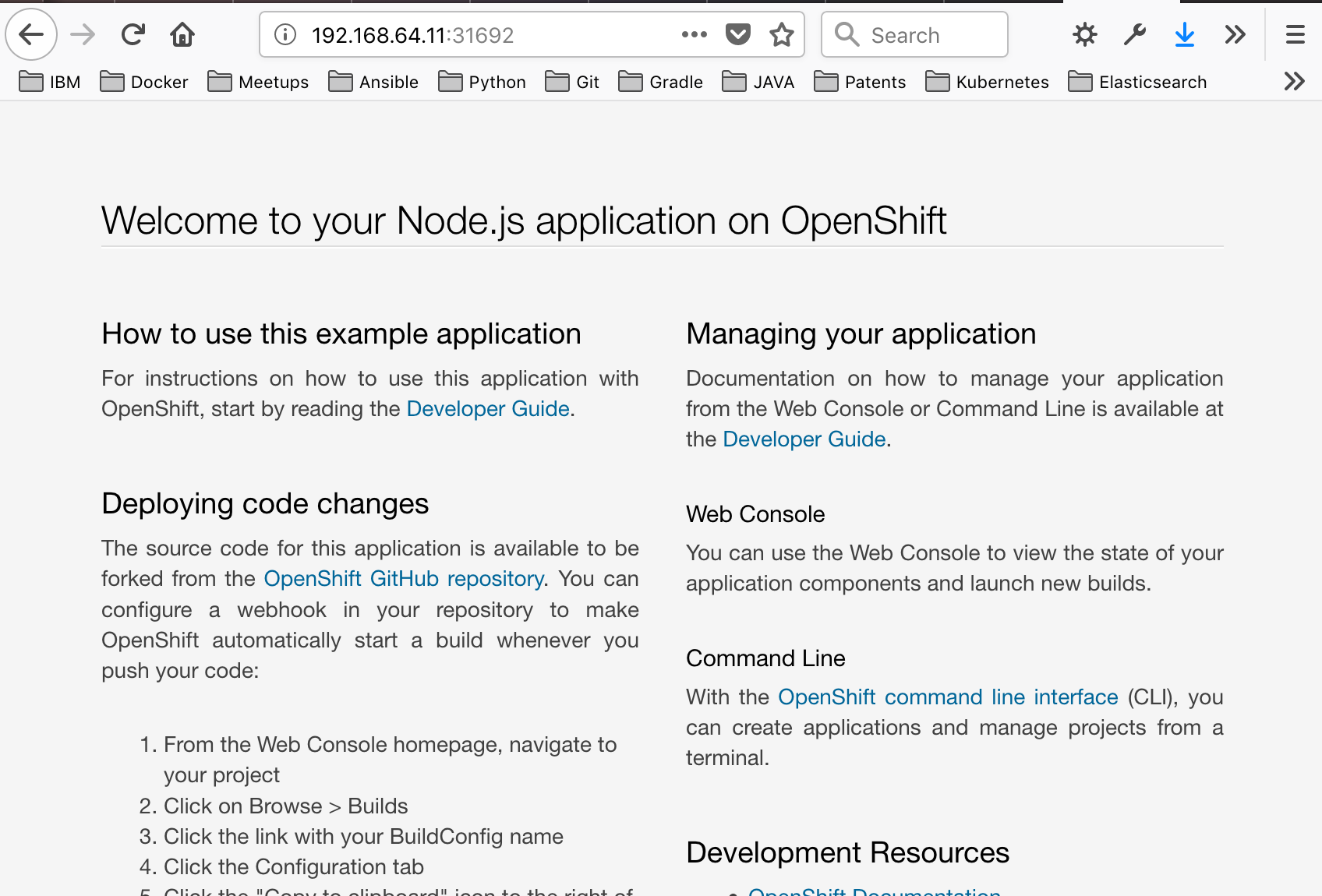minishift101
4. Exposing OpenShift applications
Once it has been verified that the application is up and running as instructed in the previous lab (Lab 3), the next step is to configure access for the application outside of the cluster. There are several ways to do this:
- Node-port services
- Port-forwarding
- Routes
4.1 Node port services
This is the cleanest way to access the applications outside of OpenShift environment both locally and publicly. This way essentially makes use of the cluster node’s IPs and a port in between the range (30000-32767) and tells OpenShift to proxy to the underlying application via. the port. This is better than the next two solutions for several reasons: we don’t have to worry about port clashes, this works for non HTTP based services and finally, does not require a public host name.
To expose our deployment via NodePort, we simply expose the deployment with a load balancer type and label it with name nodejs-ex-ingress:
$ oc expose dc nodejs-ex --type=LoadBalancer --name=nodejs-ex-ingress
service/nodejs-ex-ingress exposed
To see the NodePort created, we can run:
$ oc get --export svc nodejs-ex-ingress
NAME TYPE CLUSTER-IP EXTERNAL-IP PORT(S) AGE
nodejs-ex-ingress LoadBalancer <none> 172.29.51.89 8080:31692/TCP <unknown>
We can use the NodePort in conjuction with the cluster’s internal or external IP which we can find in the following command:
$ oc get node -o wide
NAME STATUS ROLES AGE VERSION INTERNAL-IP EXTERNAL-IP OS-IMAGE KERNEL-VERSION CONTAINER-RUNTIME
localhost Ready <none> 13h v1.11.0+d4cacc0 192.168.64.11 <none> CentOS Linux 7 (Core) 3.10.0-957.5.1.el7.x86_64 docker://1.13.1
We should then be able to access the application in the browser. In this example, we can access the Node application at 192.168.64.11:31692:

In some cases, Internal-IP can’t be reachable (10.x.x.x) and External-IP is none
oc get node -o wide
NAME STATUS ROLES AGE VERSION INTERNAL-IP EXTERNAL-IP OS-IMAGE KERNEL-VERSION CONTAINER-RUNTIME
localhost Ready <none> 5h v1.11.0+d4cacc0 10.0.2.15 <none> CentOS Linux 7 (Core) 3.10.0-1062.9.1.el7.x86_64 docker://1.13.1
In order to retrieve the IP address of our cluster’s node, we can use minishift ip:
$ minishift ip
192.168.99.101
Hence, the URL of our applicaiton is http://192.168.99.101:31692
4.2 Port-forwarding
Alternatively, if you want to quickly access a port of a specific pod of your cluster, you can also use the oc port-forward command:
$ oc port-forward POD [LOCAL_PORT:]REMOTE_PORT
4.3 Routes
For web applications, the most common way to expose it is by a route. A route exposes the service as a host name. You can do this by running the command providing you have a host name available:
$ oc expose svc/nodejs-ex --hostname=www.example.com
Congratulations! You have completed all labs in this workshop! You have learnt how to:
- Create an OpenShift project
- Create an OpenShift application in various ways
- How to monitor the status of an application
- How to access and expose your application
Want to practice more, try to deploy this following nodeJS app by using the UI
https://github.com/IBM/node-s2i-openshift
For more information on how to navigate Minishift, check the Minishift docs